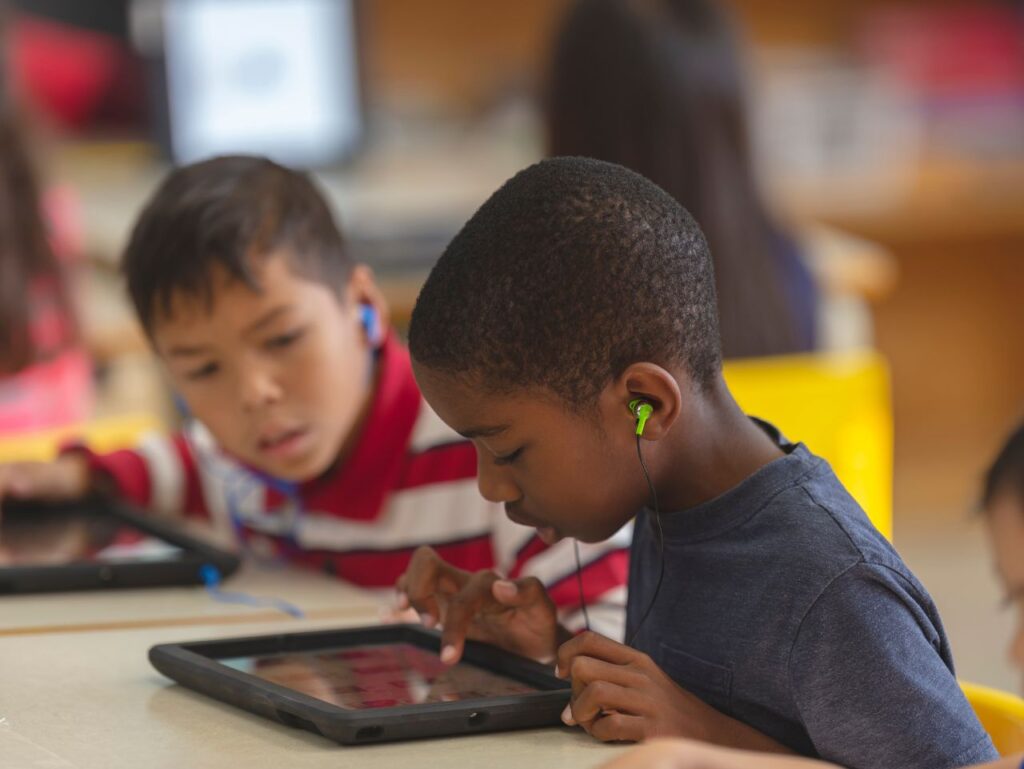e-learning
Engaging & Inspiring Learning
At Kyperr eLearners have access to the latest interactive and educational courses. For instance they go will go on a journey into a secret clubhouse and using their skills, will solve many challenges such as math drills, word scrambles, logic games, ecology, biology ,art history, and quantitative reasoning. They also use problem-solving skills to outsmart antagonists (cartoon characters) in the game to solve puzzle, unlock secret , etc. These educational games , challenging activities , and exciting adventures keeps the child involved for hours of learning fun.

Mathematics
Grade Level Specific Standards offered in Mathematics include: -Operations & Algebraic Thinking -Number & Operations in Base Ten -Geometry -Measurement & Data -Number & Operations - Fractions

English Language & Arts
-Reading Literature -Reading: Information -Reading: Foundational Skills -Writing - Speaking and Listening -Language

Interactive eSports
Interactive eSports for kids that include swordplay, frisbee, archery, wakeboarding, basketball, soccer, table tennis/tennis, bowling, canoeing, cycling, and air sports can be a fun and engaging way for kids to get active, learn new skills, and compete with their friends.
Interactive eSports for kids can be a great way to promote physical activity, cognitive development, and social interaction. It can also be a fun and engaging way for kids to learn new skills and compete with their friends.
Here are some of the benefits of interactive eSports for kids:
Physical activity: Interactive eSports can help kids to get active and stay healthy. Many of the sports that can be included in interactive eSports, such as swordplay, frisbee, archery, wakeboarding, basketball, soccer, table tennis/tennis, bowling, canoeing, cycling, and air sports, are physically demanding. By playing interactive eSports games, kids can get exercise without even realizing it.
Cognitive development: Interactive eSports can help kids to develop their cognitive skills. Many interactive eSports games require players to think strategically, make quick decisions, and solve problems. By playing these games, kids can learn to think more critically and creatively.
Social interaction: Interactive eSports can help kids to develop their social skills. Many interactive eSports games can be played with multiple players. By playing these games, kids can learn to communicate and cooperate with others.

Life Sciences
Life sciences for kids is the study of living things. It includes a wide range of topics, such as plants, animals, humans, and the environment. Life sciences can be a fun and rewarding subject for kids to learn, as it helps them to understand the world around them and how living things work.
There are many ways to teach kids about life sciences. One way is to use hands-on activities and experiments. For example, kids can plant a seed and watch it grow, or they can dissect a flower to learn about its parts. Another way to teach kids about life sciences is to use books, videos, and other resources. There are many great children's books and videos available on a variety of life science topics.
Here are some specific things that kids can learn about life sciences:
Plants: Kids can learn about the different parts of plants, how plants grow, and what plants need to survive.
Animals: Kids can learn about the different types of animals, how animals live, and what animals need to survive.
Humans: Kids can learn about the human body, how the human body works, and how to stay healthy.
Environment: Kids can learn about the different ecosystems in the world, how living things interact with their environment, and how to protect the environment.
Online Learning
Take your learning place over the internet and allow for learning to not stop when not in class.
In the past, learning was largely confined to the classroom. Students would attend school for a set number of hours each day, and their learning would stop when they left the classroom. However, the advent of the internet has revolutionized the way we learn. Today, students can access a vast array of educational resources online, and they can learn at their own pace and on their own time.
There are many benefits to taking your learning place over the internet. One of the biggest benefits is that it allows you to learn at your own pace. If you’re struggling with a particular concept, you can spend more time on it until you understand it. If you’re ahead of the curve, you can move on to more challenging material.
In-Class Learning
In- Class Learning promotes collaborative learning through enhanced thinking skills and social skills.
Collaborative learning is a type of learning in which students work together to achieve a common goal. It is a powerful educational approach that can promote enhanced thinking skills and social skills.
Enhanced thinking skills
Collaborative learning encourages students to think critically and evaluate their peers’ ideas and arguments. This helps to develop their analytical skills and promotes higher-level thinking. For example, when students are working on a group project, they need to be able to identify and analyze different perspectives, synthesize information, and come up with a shared solution. This process requires them to use their critical thinking skills to a high degree.
Enhanced social skills
Collaborative learning also helps students to develop important social skills such as communication, teamwork, and conflict resolution. When students are working together on a task, they need to be able to communicate their ideas clearly, listen to others, and compromise. They also need to be able to work together as a team to achieve their goal. These social skills are essential for success in both school and the workplace.
Distance Learning
Distance learning allows students to learn from anywhere in the world without having to attend a traditional classroom. This makes it a flexible and convenient option for students with busy schedules, who live in remote areas, or who have other challenges that make traditional classroom learning difficult.
One of the biggest benefits of distance learning is its flexibility. Students can choose when and where they want to learn, and they can learn at their own pace. This is ideal for students who have jobs, families, or other commitments. Distance learning can also be a good option for students who have difficulty commuting to a traditional classroom.
Another benefit of distance learning is that it can eliminate the hassles of having to commute. Students don’t have to spend time and money getting to and from class, and they don’t have to worry about traffic, parking, or other delays. This can save students a lot of time and stress.
In addition to its flexibility and convenience, distance learning can also be a very effective way to learn. Many distance learning programs use innovative teaching methods and technologies to engage students and promote learning. For example, many distance learning programs use online discussion forums, video conferencing, and other interactive tools to connect students with their instructors and classmates.

